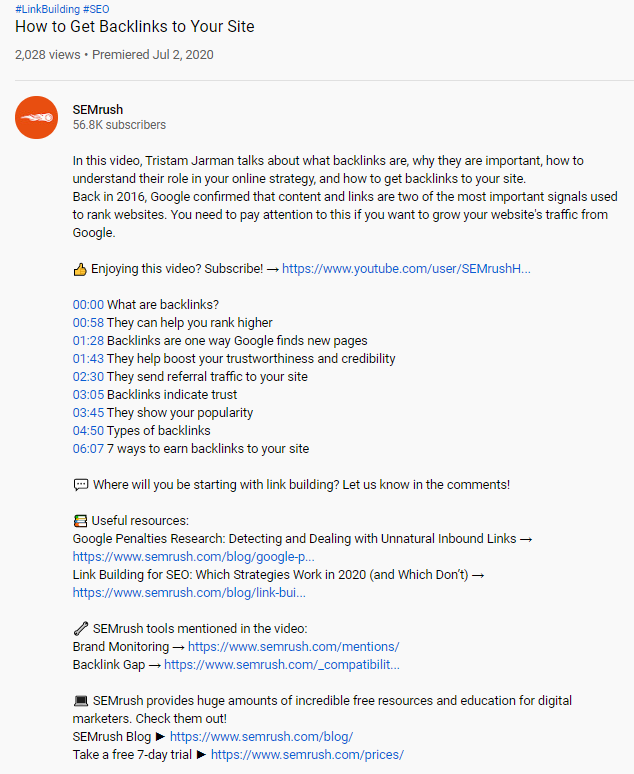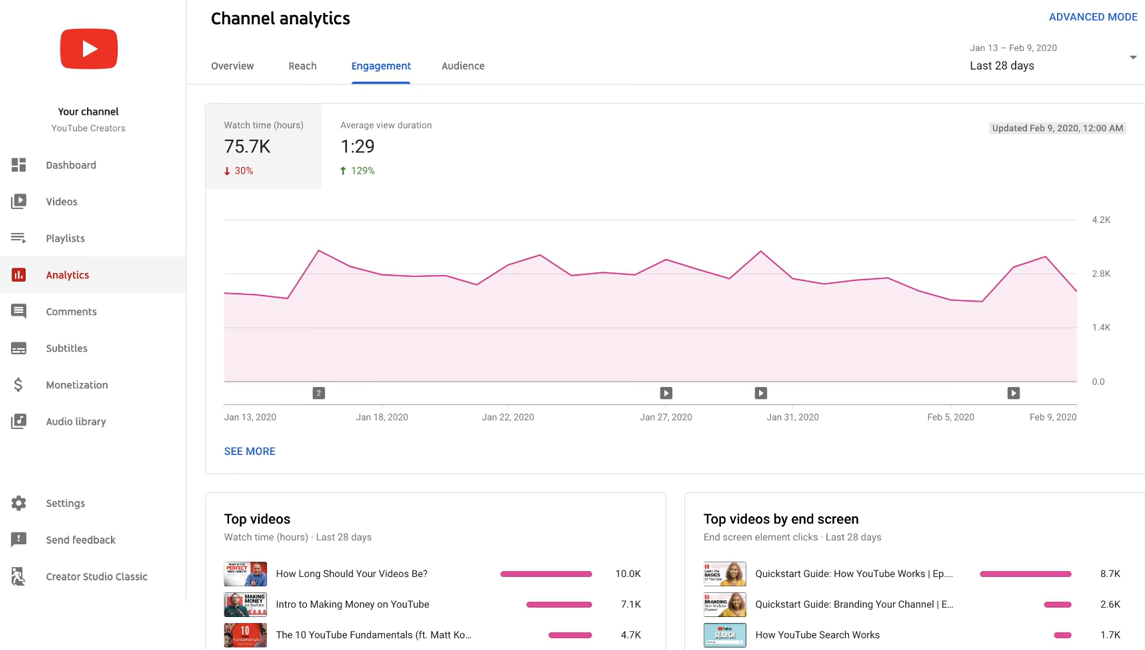
Youtube SEO Optimization Strategies for best results
Having trouble understanding YouTube SEO? We comprehend. It can be challenging to launch your channel.
You can increase the visibility of your channels and your videos by learning about YouTube marketing and SEO.
According to recent statistics, the second-largest search engine in the world is currently YouTube. The amount of videos being watched is also at an all-time high.
Contrary to popular assumption, mastering YouTube SEO doesn’t call for a ton of technical expertise or spammy techniques.
You’ll discover what YouTube SEO is and how it functions in this article. In order to help you flourish on the platform, we’ll also introduce you to the best YouTube SEO tactics and tools.
What is YouTube SEO?
The practice of optimizing your channels and videos for YouTube search results is known as YouTube SEO. It entails utilizing a range of tactics and strategies to increase organic traffic and expose your content to your target market.
How does YouTube SEO work?
SEO for YouTube functions slightly differently than standard SEO.
Because they can’t really watch videos, search engines can crawl the text that goes with them. They consist of tags, titles, descriptions, transcripts, and closed captions.
Every YouTube SEO strategy must include the use of pertinent keywords and phrases in these text elements.
In addition to producing high-quality, compelling material, maximizing these factors also aids in improving viewer experience, which directly increases the popularity of your video.
The YouTube algorithm is more likely to push your material to the top of search results if it resonates well with your audience.
YouTube SEO techniques
We’ll examine a number of YouTube SEO tactics in this section to help you push your videos to the top of search results.
1. Perform keyword research
Investigating the most popular video themes should come first.
By design, YouTube does a good job of letting creators know what their audience wants. You may find a ton of terms from genuine viewers by just typing a term or keyword into the search bar on YouTube.
It’s not always necessary to copy the terms that are already popular while conducting keyword research. Alternatively, you can use these terms to research fresh ideas for themes and discover other keyword chances.
Google is a further resource for video SEO studies. That’s because YouTube videos appear in Google results, which means that they are almost certainly already SEO-optimized when they appear in a search. The titles and thumbnails that these videos that top the search use are to be taken into account.
The Google Keyword Planner tool and other SEO tools like Keywords Everywhere are other options for conducting keyword research. The added benefit of using Google is that you can learn about actual search phrases that people are using, even if this is unrelated to video SEO per se.
Finding out what your audience wants and generating ideas are two purposes of keyword research. A low-hanging technique to improve your ranks in comparison to videos that completely ignore YouTube SEO is by incorporating keywords and related terms throughout your material.

2. Add hashtags to your videos
Using hashtags is a terrific technique to increase the visibility of your videos. You can include pertinent hashtags in the titles and/or descriptions of your videos.
Users can click or search for hashtags on YouTube to watch material connected to particular themes, just like on other social media sites.
Use caution while deciding how many hashtags to use. Avoid using too many or your material can seem spammy. Keep your list to a maximum of 2-3 of the most pertinent terms, such as your company name, brand name, and primary theme.
Read YouTube tools to grow your audience faster
3. Create a playlist
Playlists encourage visitors to stay on your channel for longer, increasing your overall watch time and maybe improving your position in search results.
On YouTube, creating playlists for your material makes it simpler for users to search for and watch related videos.
Last but not least, playlists aid YouTube in comprehending the subject matter and material of your channel, which may enhance your search exposure.
Use descriptive names with important keywords, add suitable tags, and make frequent revisions to your playlists to improve their SEO.
4. Optimize your video titles and descriptions
Making or breaking your video depends on its intriguing title and description. These are excellent locations to emphasize your term.
How to optimize YouTube video titles
You must carefully choose your phrases because 75 characters are often considered to be the sweet spot for titles.
Here are some title forms that follow the best practices for writing headlines and enable you to smoothly incorporate your keyword concepts:
- Ask a query, such as, “Why?” or “What is?”
- Create a listicle (such as “The Top 5” or “5 Reasons Why…”).
- Tutorials and how-tos (“How to…”)
- Comparison (“Ranking the 5,” “Best to Worst,” etc.)
The channels that exclusively use the aforementioned formats always perform well and the channel statistics speak for themselves.
Although they aren’t the only title styles you’re limited to, they’re unquestionably the most secure choices for attracting readers’ attention and making keywords simple to use.
A side note: Steer clear of creating click-bait headlines. Because audiences are becoming weary of these strategies and are familiar with them, doing so could undermine their faith in your material.
How to optimize YouTube video descriptions
When it comes to YouTube SEO, descriptions are unquestionably important.
With only 5,000 characters available, it can be tempting to load this with keywords.
But obviously, that’s not what this area is for (and keyword stuffing could land you in trouble).
There are several legitimate ways to incorporate keywords into your YouTube descriptions without resorting to spam. Your descriptions are also essential for directing YouTube visitors to your website, landing pages, and social media accounts.
In simple terms, Don’t waste this space. To add to your description, use the following elements:
- A concise summary of your video that includes your main keyword
- Hyperlinks to additional pertinent, keyword-focused videos on your channel
- Timestamps that include pertinent search terms on your video
- Links to your website, social networks, or other promotions
For instance, this example from SEMrush does all of the above with a keyword rich-description, timestamps, and links to useful resources on their site.

5. Make the most of YouTube tags
Although your viewers is unlikely to notice tags as a subtle component of YouTube SEO, they can help increase your visibility and ranking.
However, this does not imply that you should overtag your videos.
YouTube tags have a straightforward idea: by adding descriptive terms to your films, you’re assisting YouTube in understanding the content of your videos and recommending things that are pertinent to viewers.
Five or so tends to be the sweet spot for most channels, even if YouTube itself doesn’t say how many tags are “ideal.”
Finding both is easy, whether you’re looking for sample tags or want to know what tags your rivals are using. To find the tags for a video, simply access the video, see the page source (CTRL-U), and then perform a “keywords” search (CTRL-F).
6. Create compelling thumbnails
Though thumbnails aren’t directly related to video SEO, they are essential for capturing viewers’ interest and generating clicks.
Here are some general recommended practices for YouTube thumbnails for most channels as a rule of thumb:
- Vibrant colors (either via text or background)
- The title of the video is highlighted in bold letters
- A person or an action of some kind
Thumbnails are crucial for creating your brand’s identity and bringing much-needed professionalism to your channel. With the use of the following template tools, even a design novice may produce dependable, striking thumbnails:
- Canva
- Bannersnack
- Visme
Read also 10 Ways to Monetize your YouTube Channel
7. Promote your content across networks
Let’s discuss some less technical YouTube SEO advice for increasing video engagement both on and off the platform.
Your video SEO plan should aim to increase your channel’s clicks, views, and subscriptions as these are all signals to the YouTube algorithm that can boost your overall visibility.
Requesting participation in a video
Whatever you can do to elicit a response from your viewers will help you increase engagement. Here are some pointers to help:
- Requesting feedback, “likes,” and subscribers (don’t be a coward about this, but don’t be annoying either)
- Include a call to action within your video (pose a question, for example)
- The first line of your video description should contain a call to action or a question.
By the way, you don’t need to plead for comments or likes. Just state it briefly at the beginning or finish, or add a prompt within the video that doesn’t annoy your viewers.
Sharing and promoting your content beyond YouTube
Promoting your YouTube material consistently across as many channels as you can is essential to attracting visitors. This could incorporate:
- Including movies in blog articles or on websites
- Letting your email subscribers know about your video content
- Distributing videos on social media
The final point is crucial. Because video content performs well on social media, businesses make it a point to frequently share their most recent videos on Twitter, Facebook, LinkedIn, and/or Pinterest.
8. Leverage analytics to find what’s working
The final step in YouTube SEO is reviewing your outcomes.
You may evaluate the effectiveness of your material through your YouTube statistics to learn what is and is not performing well in terms of SEO.
Your YouTube dashboard, for instance, can inform you of the following:
- What search terms do you rank for?
- What kinds of videos are successful? (Consider how-to articles vs. listicles)
- How long do your most popular videos last?
- Which videos get the greatest traffic and engagement off of platforms?

You need to be aware of your past if you want to know where your YouTube SEO strategy should go. You can investigate new topics and keywords based on your data, which completes the cycle.
Essential tools for YouTube SEO
Below are examples of essential Youtube SEO tools you can use for the best performance of your videos
- Youtube Autocomplete
- Sprout Social
- Ahref Keyword Research
- TubeBuddy
- AnswerThePublic
Conclusion: Youtube SEO Optimization Strategies for best results
YouTube SEO doesn’t need to be complicated.
You’re already well ahead of the curve when it comes to optimizing your content for greater reach if you follow the advice and guidelines above.
